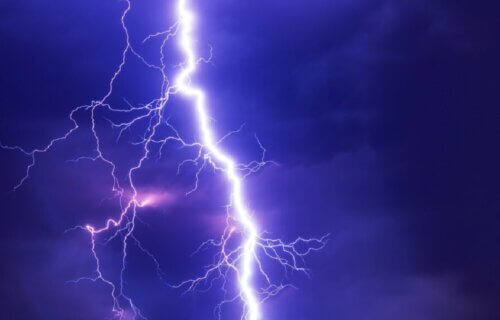RESTON, Va. — The eruption of the Tongan volcano last year produced an extraordinary display of lightning, setting a new record with 43 flashes per second. Scientists studying the volcanic plume discovered a staggering 2,615 flashes of lightning per minute at its peak, lasting for five minutes. This number of lightning flashes is more than double the previous record of 993 detected during a storm in the United States in 1999.
In addition to the high frequency of lightning, the study revealed the presence of donut-shaped rings of lightning. Overall, nearly 200,000 lightning flashes were recorded in the volcanic plume during the eruption, which lasted at least 11 hours, several hours longer than previously known.
The eruption of the underwater volcano in the southern Pacific Ocean generated a massive plume consisting of ash, water, and magmatic gas, reaching an altitude of at least 36 miles. The lightning flashes were observed at unprecedented heights, between 12 to 19 miles above sea level.
Scientists from the United States Geological Survey Cascades Volcano Observatory and Los Alamos National Laboratory employed space-based optical sensors and global networks of ground-based radio antennas to detect the lightning flashes.

“This eruption triggered a supercharged thunderstorm, the likes of which we’ve never seen,” says Alexa Van Eaton, lead researcher and volcanologist at the U.S. Geological Survey, in a media release. “These findings demonstrate a new tool we have to monitor volcanoes at the speed of light and help the USGS’s role to inform ash hazard advisories to aircraft.”
As the plume expanded outward like an umbrella cloud, it generated circular ripples called gravity waves, akin to a rock dropped in water. The accompanying donut-shaped rings of lightning expanded with the umbrella cloud and reached an astonishing diameter of 174 miles. Such large-scale “lightning holes” have never been observed before, making this a groundbreaking discovery.
“With this eruption, we discovered that volcanic plumes can create the conditions for lightning far beyond the realm of meteorological thunderstorms we’ve previously observed,” says Van Eaton. “It turns out, volcanic eruptions can create more extreme lightning than any other kind of storm on Earth.”

Authors of the study note the eruption of the Hunga Volcano was the most significant volcanic explosion since Krakatoa in 1883. The remote detection of lightning provided valuable insights into the timeline of this historic eruption and showcased the importance of using volcanic lightning to monitor volcanic activity.
The observation of lightning during volcanic eruptions offers critical information about the evolution of the event, especially when satellite observations are hindered by cloud cover. This new tool allows for real-time monitoring of volcanoes and aids in the issuance of ash hazard advisories to aircraft. The findings shed light on the intriguing and powerful natural phenomena that occur during volcanic eruptions, furthering our understanding of these awe-inspiring events.
“It was like unearthing a dinosaur and seeing it walk around on four legs,” says Van Eaton. “Sort of takes your breath away.”
The study is published in the journal Geophysical Research Letters.
South West News Service writer Jim Leffman contributed to this report.


Please, let’s not give the climate kooks anything more to fantasize on.